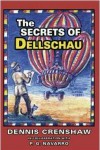An Interesting and Puzzling Tale
February 11, 2010
 The Secrets of Dellschau: The Sonora Aero Club & the Airships of the 1800s, A True Story by Dennis Crenshaw with P.G. Navarro continues to get good press. Phil Barker reviewed the book for Fortean Times and said: “…a book packed with interest, coming at a junction of several fascinating areas: outsider art, early flight, coded texts, alternative technologies and even a touch of trippy steampunk. It includes a brief resume of early flight in America and elsewhere (mostly balloon-based), [and] the UFO-like “Great Airship Mystery” of 1896-7…” His final verdict on the book? An “interesting and puzzling tale of America’s early flyboys.” Elsewhere, in the Valley Advocate, James Heflin has penned an ode to the surprises one can pick up at yard sales, estate sales, and landfills (which is just how Dellschau’s now valuable notebooks were discovered) in his feature story on the book. Writes Heflin: “Crenshaw’s book on Dellschau is an authoritative source…a fascinating voyage of exploration that opened intriguing doors of possibility.”
The Secrets of Dellschau: The Sonora Aero Club & the Airships of the 1800s, A True Story by Dennis Crenshaw with P.G. Navarro continues to get good press. Phil Barker reviewed the book for Fortean Times and said: “…a book packed with interest, coming at a junction of several fascinating areas: outsider art, early flight, coded texts, alternative technologies and even a touch of trippy steampunk. It includes a brief resume of early flight in America and elsewhere (mostly balloon-based), [and] the UFO-like “Great Airship Mystery” of 1896-7…” His final verdict on the book? An “interesting and puzzling tale of America’s early flyboys.” Elsewhere, in the Valley Advocate, James Heflin has penned an ode to the surprises one can pick up at yard sales, estate sales, and landfills (which is just how Dellschau’s now valuable notebooks were discovered) in his feature story on the book. Writes Heflin: “Crenshaw’s book on Dellschau is an authoritative source…a fascinating voyage of exploration that opened intriguing doors of possibility.”
"Wonderfully Thought-Provoking"
December 17, 2009
 The reviews of The Secrets of Dellschau: The Sonora Aero Club and the Airships of the 1800s, A True Story by Dennis Crenshaw in collaboration with P. G. Navarro are beginning to appear. “We love this book because it tells an utterly unique story which may well be related to the UFO mystery,” writes Jim Mosely in Saucer Smear. “Or, it may not.” What’s the book about? In a review of the book in Magonia Peter Rogerson writes: “When he died at the great age of 92 in 1923, Texas butcher Charles A. Dellschau left behind a secret and a mystery. These were a series of notebooks, filled with paintings of fantastic flying machines, which only came to light when his descendants had a clearout. By a process of serendipity they came to the attention of graphic designer and ufologist Peter Navarro. By decoding and translating writings in and around the pictures, Narvarro pieced together a tale of Dellschau’s involvemnt in a secret society of inventors living in gold-rush California. He created a vivid cast of over 60 characters, and a range of Heath Robinsonish flying machines, the Aeros…They were the work of this secret group, The Sonora Aero Club, and its even more shadowy backer the NYMZA.” Were these craft connected somehow to the well-known UFO flap of 1896-1897? Magonia ends its review with these words: “Whether the audience is ufologist or art appreciator, this broken old man is leading us back into the realms of pure childhood imagination.” Moseley, near the end of his review, says straight-out: “This is a wonderfully thought-provoking book…” And he kindly commends Anomalist Books “for their fortitude in publishing books of this kind.”
The reviews of The Secrets of Dellschau: The Sonora Aero Club and the Airships of the 1800s, A True Story by Dennis Crenshaw in collaboration with P. G. Navarro are beginning to appear. “We love this book because it tells an utterly unique story which may well be related to the UFO mystery,” writes Jim Mosely in Saucer Smear. “Or, it may not.” What’s the book about? In a review of the book in Magonia Peter Rogerson writes: “When he died at the great age of 92 in 1923, Texas butcher Charles A. Dellschau left behind a secret and a mystery. These were a series of notebooks, filled with paintings of fantastic flying machines, which only came to light when his descendants had a clearout. By a process of serendipity they came to the attention of graphic designer and ufologist Peter Navarro. By decoding and translating writings in and around the pictures, Narvarro pieced together a tale of Dellschau’s involvemnt in a secret society of inventors living in gold-rush California. He created a vivid cast of over 60 characters, and a range of Heath Robinsonish flying machines, the Aeros…They were the work of this secret group, The Sonora Aero Club, and its even more shadowy backer the NYMZA.” Were these craft connected somehow to the well-known UFO flap of 1896-1897? Magonia ends its review with these words: “Whether the audience is ufologist or art appreciator, this broken old man is leading us back into the realms of pure childhood imagination.” Moseley, near the end of his review, says straight-out: “This is a wonderfully thought-provoking book…” And he kindly commends Anomalist Books “for their fortitude in publishing books of this kind.”
Now Available: The Secrets of Dellschau
September 22, 2009
 It’s been a long time coming, but it’s finally here. It’s the fourth in our “Artists and Anomalies” titles (with Art, Life & UFOs, Love in An Alien Purgatory, and The Secret Art), our third “September Secrets” release (with The Secret Art and Science Fiction Secrets) and probably the most anticipated Anomalist Book to date. It’s the The Secrets Of Dellschau: The Sonora Aero Club & the Airships of the 1800s, A True Story by Dennis Crenshaw in collaboration with P.G. Navarro. Who is Charles Dellschau? He was born in 1830, in Brandenburg, Prussia, and immigrated to the United States in 1853, first settling in Texas. The historical record falls silent until 1860, when he is again shown living in Texas. The so-called “lost years” of the secretive Dellschau’s life became a matter of controversy when his voluminous, illustrated notebooks surfaced nearly a half-century after his death in 1923. Dellschau’s work – consisting of ink and watercolor illustrations of fanciful flying machines to which he frequently pasted newspaper clippings – appears to tell a coherent story of the Sonora (California) Aero Club. Using an anti-gravity gas purportedly invented by one of its members, The Club allegedly turned out a series of experimental aircraft some 50 years before the Wright Brothers first took wing. Today Dellschau is recognized as one of America’s leading visionary artists, a single page of one of his notebooks now fetches thousands of dollars. Did Charles Dellschau actually spend his lost years documenting wildly improbable inventions? Were the Aero Club’s airships also responsible for many UFO sightings in America? Or is it all a mere flight of artistic fancy?
It’s been a long time coming, but it’s finally here. It’s the fourth in our “Artists and Anomalies” titles (with Art, Life & UFOs, Love in An Alien Purgatory, and The Secret Art), our third “September Secrets” release (with The Secret Art and Science Fiction Secrets) and probably the most anticipated Anomalist Book to date. It’s the The Secrets Of Dellschau: The Sonora Aero Club & the Airships of the 1800s, A True Story by Dennis Crenshaw in collaboration with P.G. Navarro. Who is Charles Dellschau? He was born in 1830, in Brandenburg, Prussia, and immigrated to the United States in 1853, first settling in Texas. The historical record falls silent until 1860, when he is again shown living in Texas. The so-called “lost years” of the secretive Dellschau’s life became a matter of controversy when his voluminous, illustrated notebooks surfaced nearly a half-century after his death in 1923. Dellschau’s work – consisting of ink and watercolor illustrations of fanciful flying machines to which he frequently pasted newspaper clippings – appears to tell a coherent story of the Sonora (California) Aero Club. Using an anti-gravity gas purportedly invented by one of its members, The Club allegedly turned out a series of experimental aircraft some 50 years before the Wright Brothers first took wing. Today Dellschau is recognized as one of America’s leading visionary artists, a single page of one of his notebooks now fetches thousands of dollars. Did Charles Dellschau actually spend his lost years documenting wildly improbable inventions? Were the Aero Club’s airships also responsible for many UFO sightings in America? Or is it all a mere flight of artistic fancy?









